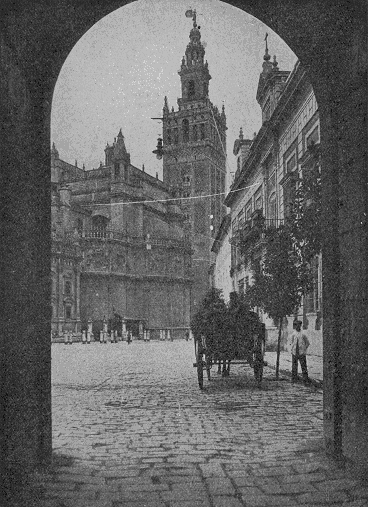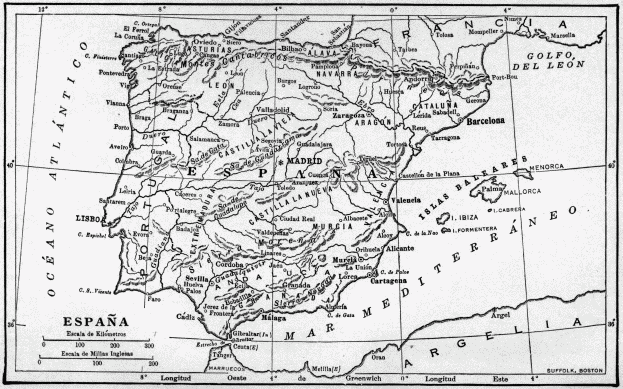
LECTURAS FÁCILES
CON EJERCICIOS
BY
LAWRENCE A. WILKINS
DIRECTOR OF MODERN LANGUAGES IN THE NEW
YORK CITY
HIGH SCHOOLS
CORRESPONDING MEMBER OF THE HISPANIC
SOCIETY OF AMERICA
AND
MAX A. LURIA
HEAD OF THE DEPARTMENT OF SPANISH, DEWITT
CLINTON
HIGH SCHOOL, NEW YORKCITY
LECTURER IN SPANISH, EXTENSION TEACHING,
HUNTER COLLEGE
NEW YORKCITY
SILVER, BURDETT AND COMPANY
BOSTON NEW YORK CHICAGO
COPYRIGHT, 1916,
BY SILVER, BURDETT AND COMPANY.

LA GIRALDA DE SEVILLA
ÍNDICE
Preface
Lista De Los Grabados
Mapas
Sección De Cuentos Europeos
Frases de uso común en la clase
3
El Viejo Y El Asno
8
La Piedra En El Camino
11
La Mona
14
El Juez Y El Escarabajo
14
Un Cuento De Un Perro
17
El Príncipe Y La Araña
19
La Perla Y El Diamante
22
El Muchacho Y El Lobo
22
El León Y El Conejo
24
El Camello Perdido
25
El Árabe Hambriento
28
El Oso
29
Abuelo Y Nieto
32
La Chimenea
35
Un Juez Moro
36
Pensamientos
42
El Persa Verídico
42
El Flautista De Hamelin
46
La Riña
49
El Muchacho Héroe
50
No Son Toros Todo Lo Que Se Dibuja
53
El Leñador Honrado
56
De "La Vida Es Sueño"
60
El Último Juguete
60
Versos
65
El Buen Rey
66
Arabesco
69
Niños Precoces
69
La Lección
73
Sección Panamericana
América
77
Colón
78
El Combate De Diego Pérez
83
El "Mayflower"
86
Emilio Castelar
90
El Cura Y El Sacristán
92
El Español De Varias Partes
95
El Canal De Panamá
100
Puerto Rico
104
La República Argentina
109
El Espantajo
116
El Brasil
121
El Café
127
Chile
130
El Arrepentimiento De Un Penitente
135
Una Visita A Costa Rica
140
Cuenca, La Ciudad Meridional Del Ecuador
144
El Juez Ladrón Y El Ladrón Juez
147
Méjico
153
El Perú
158
El Alacrán De Fray Gómez
163
Venezuela
166
Refranes
170
Apéndice De Verbos
172
Vocabulario
207
PREFACE
THIS book is the result of the conviction of the authors, after severalyears of experience teaching the Spanish language, that it isdiscouraging to the students of that language, as well as acontravention of all common-sense pedagogy, to place before them asreading material in the first year or year and a half, selections fromclassic Spanish novelists and short story writers.
Such writings canonly be understood and appreciated after considerable training in thefundamentals of Spanish, a language abounding in intricate idiomaticexpressions and having great wealth of vocabulary. Such writings do notprovide the student with a working vocabulary of the more common andpractical terms. To read, for instance, Alarcón's Capitán Veneno oreven Valera's El Pájaro Verde in the second or third semester of thestudy of Spanish in high schools, seems a sheer tour de force,resulting in neither a practical vocabulary nor a proper appreciation ofthese little masterpieces. Yet the strongest claim, at least at present,that can be made for a place for Spanish in the educational scheme ofthe United States is that it is a "practical"
language for NorthAmericans to know (being, as a mother-tongue in the New World, second inimportance only to English), while at the same time affording as goodlinguistic training as does a study of either French or German. But thetask of the Spanish teacher has for many years been complicated in thiscountry because no material other than that of a purely literary naturehas been available for the reading work in elementary classes.
The present volume, it is believed, provides in every-day, idiomaticSpanish, stories and articles that are simple and yet not childish, thatcan be readily appreciated by the beginner and yet withal are "muyespañol." It is suggested that it be used in the second and thirdsemesters of the high school or in the first and second semesters ofcollege, a proper place for it being determined by the age of thestudents and their previous linguistic training.
The first part, Sección de Cuentos Europeos, is based chiefly upon the Libro Segundo de Lectura and the Libro Tercero de Lectura of theseries published by Silver, Burdett & Company for use in the schools ofSpanish-speaking countries. Our thanks are given to this company forpermission to use this material and for aid in preparing this part ofthe manuscript.
The second part, Sección Panamericana, provides in Spanish interestinginformation about Latin-American countries and will serve, it is hoped,to increase, in some slight measure at least, the awakening realizationamong North Americans, especially
among young people, of the importantplace held by our sister republics of America in the resources andcommerce of the world. Those articles upon Argentina, Brazil, Cuenca,Costa Rica, and Peru are adapted from various articles appearing in thepublications of the Pan American Union, to the officers of whichsociety, especially to Mr. Francisco J. Yánes, the Assistant Director,our thanks are extended for permission to use this material in this way;also for permission to reproduce in this part several of theirphotographs of South American scenes.
Upon the selections in both parts of the book are based exercises ofvarious types. The authors believe that especial value is attached tothat form of exercise which requires working over in various ways theidioms found in the text. These idioms, selected by means of footnotes,not only aid the student in reading the text, but are of still greaterimportance in furnishing a basis for the exercises on Spanish locutionsgiven in connection with nearly every story or article. It will be foundthat the same idiom has in some cases been selected several times in thebook, but this has been done purposely for one or both of two reasons:the idiom is important and frequent in the language, or other stories ofthe book containing the idiom may not have been read before by theclass. Other exercises are: cuestionarios to be answered orally or inwriting; verb drills consisting chiefly of writing synopses of verbs;plans for the dramatization of stories; directions for giving summaries,oral and written, of stories read; word-studies (English and Spanishcognates, grouping of Spanish words of the same root, etc.); observationand description of the pictures of the text; memory passages; thecompletion of incomplete sentences based on a story read; all of which,especially in high school classes, the instructor will find desirable tohave the students work out fully.
It will be found that each English-Spanish exercise can be done byreference to the idioms and vocabulary of the article upon which it isbased. For that reason no English-Spanish vocabulary has been provided.
The important proper nouns that occur in the text are amply explained inthe Spanish-English vocabulary.
It is believed that the very full conjugations of the type-verbs of theregular conjugations given in the Apéndice de Verbos may prove to be agreat help as also may the outlines of all the common irregular verbsand the type classes of the radicalchanging and orthographical-changingverbs included in this appendix. Reference may be made to theseparadigms, if necessary, when the pupil writes out the synopses andother verb drills asked for in the exercises.
The reading matter in the first section of the book is arranged inincreasing order of difficulty, but after the first few stories havebeen covered the selections may be read in any order. Many will be foundsuitable for sight reading, especially the informational articles onSpanish-American countries.
Finally, it is hoped that in the use of this reader and its exercises,together with its section of classroom expressions and grammaticalnomenclature in Spanish, the "read and translate"
method may berelegated to at least second—may we hope to third?—place in the listof the many possible ways of covering a reading lesson in Spanish.
To our colleague Mr. Modesto Solé y Andreu, we are especially indebtedfor reading the book in manuscript and for helpful suggestions givenfrom time to time in the preparation thereof. Needless to say, he is inno sense responsible for its shortcomings.
L. A. W.
M. A. L.
SEPTEMBER, 1916.
LISTA DE LOS GRABADOS
La Giralda de Sevilla
Un Vendedor de Botijos
El Palacio Real de la Granja
Una Calle de una Aldea Española
Un Olivar de España
Una Ventana de la Alhambra
El Patio de los Arrayanes de la Alhambra
La Plaza Mayor, Burgos
Un Rincón de Sevilla
La Salida de las Cuadrillas
Pasto para las Bestias
Una Calle Sevillana
Cristóbal Colón
La Santa María
Una Brújula
El "Mayflower" en el Puerto de Plymouth
El Estadista Castelar
Un Rebaño de Ovejas en un Rancho Chileno
Las Esclusas de Pedro Miguel Miradas desde el Norte, Agosto de 1910
Las Esclusas de Gatún
El Corte de Culebra del Canal de Panamá
Vendedores de Sombreros, Puerto Rico
Las Palmas de Puerto Rico
Regatas de Buques en el Puerto de San Juan
El Acarreo do la Lana, Argentina
La Plaza de Congreso, Buenos Aires
Ganado de una Estancia Argentina
Mulas de Carga, los Andes
Panorama de la Bahía y Ciudad de Río de Janeiro
Secando el Café en el Brasil
Un Cafetal Brasileño
Vaqueros Chilenos
Un Yacimiento de Nitrato
Minando el Salitre
Llamas de los Andes
El Puerto de Valparaíso
Recogiendo las Bananas de Costa Rica
El Seminario de Cuenca
La Catedral de la Ciudad de Méjico
En la Región Minera del Perú
Una Tumba de los Incas
El Monte Misti y el Observatorio de Harvard
Un Aguador Inca
Un Cañón de los Andes en la Línea Ferroviaria de Oroya
Estatua de Bolívar, Plaza de Caracas, Caracas, Venezuela
En el Mercado de Caracas
MAPAS
España
América del Sur
América Central
[Page 2]

MAPA DE ESPAÑA
[VIEW ENLARGED]
SECCIÓN DE CUENTOS EUROPEOS
Page
[3]
LECTURAS FÁCILES
[Transcriber's note: The spelling and accentuation of the Spanish in the original, hard book have been retained.A small number of words which appear here with accent are no longeraccented in modern-day Spanish: vi (ví) vio (vió) fui (fuí) fue (fué)and dio (dió) construido (construído) heroica (heróica).]
FRASES DE USO COMÚN EN LA CLASE
Saludos y despedidas
Buenos días, profesor, profesora. Good morning, teacher.
Buenas tardes. Good afternoon.
Buenas noches. Good evening, good night.
¿Cómo está usted?
¿Cómo lo pasa usted?
How are you?
¿Cómo se encuentra usted?
¿Qué tal?
¡Hasta luego!
See you later!
¡Hasta más tarde!
¡Hasta la vista! Till we meet again!
¡Adiós! Good-bye!
Asistencia y puntualidad
Voy a pasar lista a la clase. I am going to call the roll.
Juan Brown. Presente. John Brown. Here.
¿Quién está ausente? Who is absent?
¿Quién sabe la causa de la ausencia de la señorita Smith?
Who knows whyMiss Smith is absent?
¿Por qué llega usted tarde? Why are you late?
¿Cómo se llama usted? What is your name?
Me llamo Pedro Smith, para servirle a usted. My name is Page
[4]Peter Smith,at your service.
Fórmulas de cortesía
Fórmulas de cortesía
Haga usted el favor de
(más el infinitivo).
Please (plus the infinitive).
Tenga usted la bondad de
(más el infinitivo).
Gracias. Muchas gracias. Mil gracias. Thank you.
De nada. No hay de que. Don't mention it.
Dispénseme usted. Con permiso suyo. Excuse me.
La lección de lectura
Póngase usted de pie. Rise.
¿Cuál es la lección para hoy? What is the lesson for to-day?
Abra usted el libro. Open your book.
Lea usted. You may read.
¿Lo entiende usted? Do you understand it?
Traduzca usted al inglés. Translate into English.
Dígame usted en español lo que acaba de leer. Tell me in Spanish whatyou have just read.
Siga usted leyendo. Continue reading.
Repita usted cuando le corrijo. Repeat when I correct you.
Usted pronuncia muy bien. You pronounce very well.
No lea usted tan de prisa. Do not read so fast.
En el pizarrónVaya usted al pizarrón. Go to the blackboard.
Tome us






